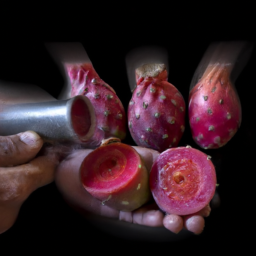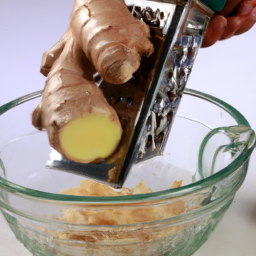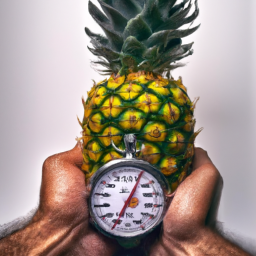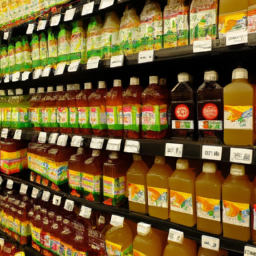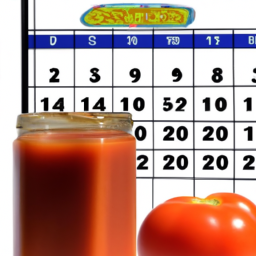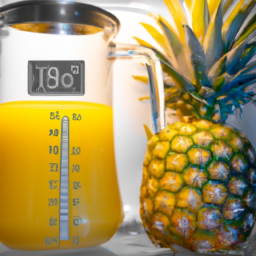I have discovered that juicing is a great way to incorporate more fruits and vegetables into my diet. Recently, I came across the prickly pear, a fruit from the cactus family that is not only delicious but also packed with nutritional benefits.
Not knowing how to juice it initially, I did some research and discovered that it is actually quite simple. In this article, I will share with you my process for juicing prickly pears and how to enjoy the juice in creative ways.
Prickly pear juice is known for its ability to boost the immune system, aid in digestion, and even regulate blood sugar levels. Not to mention, it’s a low-calorie option that is perfect for those looking to cut down on sugar and carbs.
The prickly pear fruit itself may look intimidating with its spiky exterior, but once you know how to prepare it, juicing becomes a breeze. So, if you’re interested in trying something new and healthy, keep reading to learn how to juice a prickly pear.
Key Takeaways
- Look for bright, vibrant colors and a slightly soft texture when selecting prickly pears.
- Use a sharp knife or tongs to remove spines and a sharp knife or vegetable peeler to peel the skin.
- Prickly pear juice can be made using a juicer, blender, or by squeezing by hand and can be mixed with spirits and flavors to create unique cocktails.
- Store prickly pear juice in an airtight container in the fridge or freeze in ice cube trays for later use in mocktails, smoothies, and marinades.
Understanding the Health Benefits of Prickly Pear Juice
You’ll be happy to know that drinking prickly pear juice can provide you with a plethora of health benefits. These benefits include reducing inflammation and improving digestion. Prickly pears are high in fiber, antioxidants, and vitamin C, making them a great addition to any healthy diet. Studies have shown that consuming prickly pear can also aid in managing blood sugar levels and cholesterol.
However, it’s important to note that consuming too much prickly pear juice can have potential health risks. The fruit contains oxalic acid, which can interfere with the absorption of calcium and lead to kidney stones. It’s important to consume prickly pear juice in moderation and speak to a healthcare provider if you have any concerns about incorporating it into your diet.
Now that we’ve covered the nutritional value and potential health risks of prickly pear juice, let’s move on to selecting the perfect prickly pear.
Selecting the Perfect Prickly Pear
When it comes to selecting the perfect prickly pear, it’s important to know what to look for.
As someone who has experience with this, I always make sure to identify ripe prickly pears by looking for bright, vibrant colors and a slightly soft texture.
Additionally, it’s crucial to avoid any damaged or overripe fruit, which can impact the taste and quality of the juice.
Identifying ripe prickly pears
Once they’re as soft as a ripe avocado, you can be sure that the prickly pears are ready to be juiced. Identifying ripeness is crucial to ensure that you get the best flavor and juice yield from the fruit. Common varieties of prickly pears include the red-purple skinned fruit with deep red flesh and the green-yellow skinned fruit with pale yellow flesh. Regardless of the variety, the fruit should be plump, firm, and free from blemishes or bruises.
To help you identify ripe prickly pears, refer to the table below:
| Characteristics | Ripe Fruit |
|---|---|
| Skin | Vibrant color, plump and firm |
| Spines | Less sharp and more flexible |
| Flesh | Soft and juicy, sweet aroma |
| Seeds | Dark and hard |
It’s important to avoid damaged or overripe fruit as this can affect the quality of the juice. Look for fruits that are just ripe, with a slight give when gently squeezed. Overripe fruits may appear wrinkled or have soft spots, while damaged ones may have visible cuts or bruises. By selecting the right fruits, you’ll be on your way to making a delicious prickly pear juice.
Avoiding damaged or overripe fruit
To ensure the best quality of your final product, it’s crucial to carefully select only firm, plump, and undamaged fruit when harvesting. Avoiding damaged or overripe fruit is key to achieving the best flavor and yield.
Here are some tips for harvesting prickly pears:
- Look for fruit that’s bright in color and firm to the touch.
- Avoid fruit with soft spots or areas of discoloration.
- Check for signs of insect damage or mold growth.
- Harvest fruit that’s still attached to the plant and use pruning shears to avoid damaging the spines.
By following these tips, you can ensure that your prickly pears are at their peak ripeness and ready for juicing.
Once you’ve selected your fruit, it’s time to move on to the next step of preparing the prickly pear.
Preparing the Prickly Pear
Now that I’ve selected the perfect prickly pear, it’s time to prepare it for juicing.
The first step is to remove the spines, which can be done using a sharp knife or tongs.
Then, I need to peel the skin, which can be a bit tricky as the skin is thick and tough.
Removing the spines
Be careful when handling the prickly pear, those spines can really hurt you! To remove them, it’s important to wear protective gear such as gloves and long sleeves. If you don’t have these items, there are alternative methods to remove the spines. For example, you can use a piece of duct tape to gently lift them off the surface of the fruit. Another option is to place the prickly pear in the freezer for a few hours, which will cause the spines to become brittle and easier to remove.
Once the spines are removed, the prickly pear is ready to be peeled. It’s important to handle the fruit carefully as it can still have small, hair-like spines called glochids on its surface. To avoid getting them in your skin, use tongs or a fork to hold the fruit in place while peeling it.
Peeling the skin
As you start peeling the skin off, the prickles will reveal a smooth and succulent flesh. But before we get to that, let’s talk about the skin peeling techniques.
You can use a sharp knife to cut off both ends of the fruit and then make a lengthwise cut down the skin to remove it. Alternatively, you can use your hands and gently pull the skin off, starting from the top and working your way down.
Now, let’s talk about the benefits of prickly pear skin. While most people discard the skin, it’s actually packed with nutrients such as fiber, antioxidants, and vitamin C. Eating the skin can also help regulate blood sugar levels and improve digestion. So, don’t be afraid to consume the skin along with the flesh when juicing a prickly pear.
Moving on to the next step, extracting the juice, you can either blend the fruit and strain it through a cheesecloth or use a juicer.
Extracting the Juice
First, grab your prickly pear and slice off the top and bottom using a sharp knife, then make a deep cut lengthwise down the fruit.
Next, peel off the skin carefully using a vegetable peeler or a sharp knife.
Now that your prickly pear is peeled, it’s time to extract the juice. To extract the juice, there are several techniques you can use. Here are some options:
- Use a juicer: This is the easiest and most efficient method. Simply cut the prickly pear into small pieces and feed them through the juicer.
- Use a blender: Cut the prickly pear into small pieces and blend them until smooth. Strain the mixture through a fine mesh sieve to remove any pulp or seeds.
- Squeeze by hand: Cut the prickly pear in half and squeeze out the juice over a bowl or container. This method may take longer and require more effort, but it works just as well.
Once you have extracted your prickly pear juice, you can use it in a variety of ways, including adding it to cocktails for a unique flavor.
Now that we have our juice, let’s move on to the next step of mixing it into a delicious drink.
Mixing Your Prickly Pear Juice
Once you’ve extracted the sweet nectar, it’s time to mix it with your favorite spirits and flavors to create a refreshing and unique cocktail. There are many mixing techniques to choose from, depending on your preferences and the flavors you want to highlight.
For a simple yet flavorful cocktail, try mixing prickly pear juice with tequila and lime juice for a classic margarita with a twist. You can also mix it with vodka and a splash of cranberry juice for a refreshing and fruity cocktail.
If you want to get more creative with your prickly pear juice, try experimenting with different flavor combinations. For example, you can mix it with coconut water and rum for a tropical and refreshing drink, or with ginger beer and bourbon for a spicy and bold cocktail. The possibilities are endless, so don’t be afraid to try new things and find your own perfect prickly pear cocktail.
As you finish mixing your prickly pear juice to perfection, it’s important to know how to store it properly to keep it fresh.
Storing Your Prickly Pear Juice
To keep your prickly pear nectar fresh and delicious for longer, make sure to store it in an airtight container in the fridge, allowing you to savor the sweet and tangy flavors whenever you please. There are several storing techniques and preservation methods that you can use to extend the shelf life of your prickly pear juice.
One effective way to store your prickly pear juice is to pour it into an airtight glass bottle or jar, leaving about an inch of space at the top to allow for expansion. Then, place the container in the fridge and consume within 3-5 days. Another option is to freeze the juice in ice cube trays and store the cubes in a freezer-safe bag or container. When you’re ready to enjoy the juice, simply thaw a few cubes in the fridge overnight or place them in a glass of water for a refreshing prickly pear drink. With these preservation methods, you can enjoy the health benefits and delicious taste of prickly pear juice for weeks to come.
Now that you know how to store your prickly pear juice, let’s explore some creative ways to enjoy it beyond just drinking it straight.
Creative Ways to Enjoy Prickly Pear Juice
Now that you know how to store your prickly pear juice, let’s explore some creative ways to enjoy it!
One way to enjoy prickly pear juice is by making prickly pear mocktails. Simply mix the juice with your favorite spirit, such as tequila or vodka, and add some fresh lime juice for a refreshing and unique cocktail.
Another option is to make prickly pear smoothies by blending the juice with frozen fruit, yogurt, and honey for a healthy and delicious breakfast or snack. If you’re feeling adventurous, you can also use prickly pear juice in marinades for grilled meats or vegetables.
The sweet and tangy flavor pairs well with a variety of proteins and adds a unique twist to your usual grilling routine. Whatever way you choose to enjoy prickly pear juice, be sure to experiment and have fun with it!
Now that you know some creative ways to use prickly pear juice, let’s move on to some tips for cleaning up after juicing.
Tips for Cleaning Up
Keeping your kitchen clean after enjoying this delicious fruit can be a breeze with these helpful tips. Firstly, it is important to properly clean your juicer or blender immediately after use to prevent any leftover pulp from hardening and sticking. Use hot water and soap to thoroughly clean all parts of the machine. For tough, stuck-on pulp, use a brush or sponge to scrub away any residue.
Secondly, when disposing of any leftover prickly pear peels or pulp, it is important to properly dispose of it in the trash rather than down the sink or toilet. Prickly pear pulp can easily clog pipes and cause plumbing issues. Additionally, if you are composting, make sure to properly compost the peels and pulp by breaking them down into small pieces and mixing them with other compost materials.
In order to ensure a safe and enjoyable prickly pear juicing experience, it is important to take proper safety precautions when handling the fruit.
Safety Precautions When Handling Prickly Pears
It’s crucial to take proper precautions when handling these spiny fruits to avoid any potential injuries. Here are some important safety measures to keep in mind:
-
Wear gloves: Prickly pears are covered in tiny spines that can easily get embedded in your skin. Wearing gloves will help protect your hands from getting pricked.
-
Use tongs: If you don’t have gloves, use tongs to hold the prickly pear instead of your bare hands.
-
Be careful when cutting: Use a sharp knife and be mindful of the spines on the fruit. Cut off the top and bottom of the fruit, then make a lengthwise incision to peel off the skin.
-
First aid: If you do get pricked, use tweezers to remove the spines. Wash the affected area with soap and water, then apply a topical antibiotic cream to prevent infection.
By following these safety precautions, you can ensure a safe and enjoyable experience when handling prickly pears.
Frequently Asked Questions
Can you juice prickly pears with a regular juicer?
Yes, you can juice prickly pears with a regular juicer. There are various juicing methods, but prickly pears offer nutritional benefits such as high levels of antioxidants, fiber, and vitamin C.
Are prickly pears safe to consume if you are allergic to other types of cactus?
As someone with cross allergies to certain types of cactus, I take precautionary measures before consuming prickly pears. It’s best to consult with a doctor and start with a small amount to monitor any allergic reactions.
How long does it take for prickly pear juice to spoil?
How long can you store prickly pear juice? Once opened, refrigerate and consume within 5-7 days. Unopened bottles can last up to 6 months in a cool, dry place. Check for discoloration or off flavors before consuming.
Can you freeze prickly pear juice for later use?
Yes, you can freeze prickly pear juice for later use. To preserve the flavor, use airtight containers or freezer bags and leave some headspace for expansion. Thaw in the fridge before using.
What are some common mistakes to avoid when juicing prickly pears?
When juicing prickly pears, common mistakes include not wearing gloves, not properly cutting off the tough outer skin, and not removing the tiny spines. Best practices involve using a sharp knife, a high-powered blender, and straining the juice before drinking.
Conclusion
After juicing my first prickly pear, I can confidently say that it’s worth the effort due to its health benefits, unique taste, and vibrant color. It may seem intimidating at first, but selecting the perfect prickly pear and preparing it properly can result in a delicious and nutritious juice.
I was pleasantly surprised to learn about the various health benefits of prickly pear juice. It can lower cholesterol and aid in digestion, making it a great addition to your diet. Plus, its sweet and tangy flavor makes it a refreshing alternative to traditional juices.
Overall, I highly recommend giving prickly pear juice a try and experimenting with different mix-ins to find your perfect combination.
Ilana has been a vegan for over 10 years. She originally made the switch for health reasons, but soon found herself becoming more and more passionate about the ethical and environmental implications of a vegan lifestyle. Ilana is the author of The Graceful Kitchen, a blog all about veganism. She loves to cook up delicious and nutritious vegan meals, and share her recipes with others who are interested in leading a cruelty-free life. Ilana is also a strong advocate for using whole foods as the foundation of a healthy diet, and believes that going vegan is one of the best ways to achieve this.
